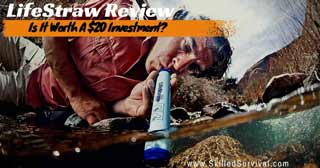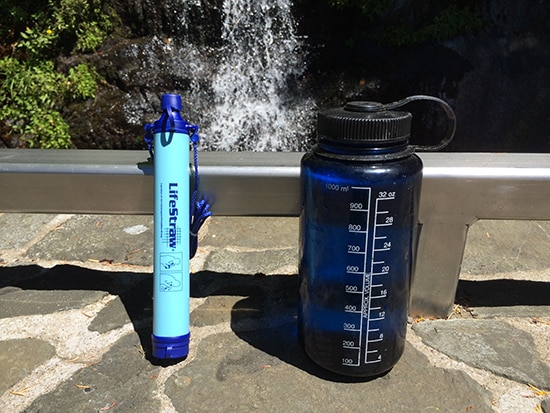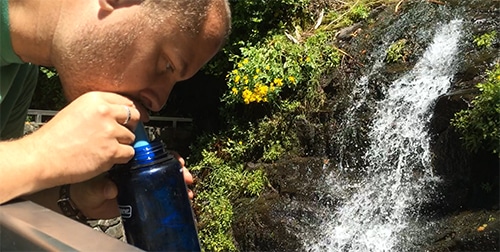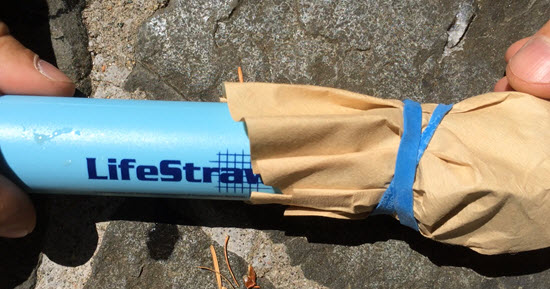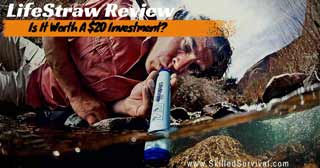
I’m guessing you answered “yes” to that question.
I’d also guess that you’ve never really been thirsty.
With access to drinking water, we take our seemingly endless supply of water for granted.
Most of us have never really experienced the pains associated with true thirst.
This is a good thing.
It means we live in a society where most of us have access to plenty of life-giving H2O.
Now, don’t go trying this at home, but after you’ve gone more than 24 hours without a single sip of water because that’s when you’ll start getting severely dehydrated.
Could you imagine going 48-72 hours without water?
You probably can’t and I hope you never have to since you’d likely be close to death by that point.
Do you know what’s even worse than being thirsty and not having water?
Being thirsty with only dirty, contaminated water and no way to safely drink it.
As A Way To Introduce You To Skilled Survival, We’re Giving Away Our #78 Item Complete Prepper Checklist. Click Here To Get Your FREE Copy Of It.
The Importance of Water
Access to clean water is one of the most critical factors in survival situations. It’s often said that one can survive for three weeks without food, but only three days without water.
Once you’ve removed any immediate threats to your safety, attention should shift to finding and purifying water.
Now there are dozens of types of personal water filters on the market. Each filter has different designs and capabilities.
Traditionally, these filters were bulky, heavy, and included mechanical parts prone to wear.
Recently, UV sterilization systems have entered the market. But these methods can fail unexpectedly when batteries run low.
And failures in survival situations can be the difference between life and death.
Our LifeStraw Review Field Test
In the past few weeks, we’ve had a chance to field-test the LifeStraw Personal Water Filter. It’s one of the most user-friendly water filtration systems out there.
With no moving parts, chemical additions, or batteries, the LifeStraw provides a lightweight, and compact filter option. It’s capable of treating up to 1000L of drinking water at a price tag of around $20.
The LifeStraw started as a humanitarian relief tool.
It’s an inexpensive, single-use water filter with a simple design. It also can treat raw water for a variety of dangerous pathogens.
Since 2005, it has been widely distributed in relief efforts throughout the world.
Beginning in 2011, the excess supply has been available to the public for purchase. Since then they’ve become popular for camping, hunting, backcountry, and survival situations.
Here’s a short LifeStraw review video from Jason’s (Skilled Survival’s resident survival and preparedness gear expert) LifeStraw field test.
Be sure to watch it to pick up on the one tip (using a common household item) that you’re going to want to deploy when drinking really murky water with your LifeStraw.
The Life Straw Filter Design
The one-piece design consists of an 8” long, 1.25” diameter plastic tube. With a mouthpiece on one end and an intake screen on the other.
Both the mouthpiece and the intake include protective caps to keep them clean and secure. This ensures untreated water doesn’t contaminate the system – or the interior of your pack.
Inside the tube is the working heart of the filter. It’s a closely packed series of hollow-fiber membrane tubes. The design allows water to pass while removing all particulates larger than 0.2 microns.
Filter media of this size is effective against nearly all common bacteria and protozoa. As well as all suspended solids.
The LifeStraw has a listed weight of 2oz dry. But will retain another ounce of water in the filter material after the first use.
Despite this increase, it still ranks among the lightest filters on the market.
As A Way To Introduce You To Skilled Survival, We’re Giving Away Our Ultimate Survival Gear Checklist. Click Here To Get Your FREE Copy Of It.
How To Use A LifeStraw Water Filter
Using your LifeStraw is extremely straightforward.
While you can drink directly from lakes, rivers, and even puddles, it’s often easier to fill a wide-mouthed water bottle like a Nalgene bottle as shown below.
This allows you to drink without crouching down to the water surface. It also allows you to carry some water along the trail between sources.
To use, simply uncapping both ends of the LifeStraw. Place the inlet end into your water source and start sucking a small amount of water to wet the filter.
This will start the flow of water within a few seconds.
Straight from the package, we found the initial couple of sips of water to have a slight chemical taste. However, that disappeared within a minute.
The initial flow rates are impressive. There was only a slight amount of resistance as water passes through the filter material.
Maintaining Your LifeStraw Filter
Once you’re finished drinking, you should clear the LifeStraw of excess water.
Do this by blowing through the straw, followed by shaking excess water off and recapping the ends.
Over time the flow rate will begin to drop. Or you might notice a significant increase in the amount of suction needed to produce water.
Once this occurs, blowback through the straw to clear any clogging particulates.
As the filter approaches the end of its useful life, you’ll slowly lose the ability to clear this blockage.
1000L isn’t a hard limit. The manufacturer has tested the LifeStraw past the designed lifespan.
However, you can expect to have more difficulty producing water beyond that point.
To extend the life even further, choose the cleanest, most transparent water available to you for use. And if possible “prefilter” before using your LifeStraw.
In our experience, any mechanical filter system can benefit from a “pre-filter.”
This simple extra step will reduce the load on your LifeStraw’s filter thus extending its useful life.
As A Way To Introduce You To Skilled Survival, We’re Giving Away Our Ultimate Survival Gear Checklist. Click Here To Get Your FREE Copy Of It.
Try wrapping a clean survival bandana or paper coffee filter around the inlet of the straw.
This will help remove the larger suspended materials (mud, sand, algae, etc.) from the water before entering your Life Straw.
Despite the obvious benefits of THE LifeStraw, there are some situations where it may not be the best solution.
The LifeStraw does not filter dissolved salts, chemicals, minerals, viruses, heavy metals, or “tastes.”
Many of these items are present in the water at a molecular level. Far smaller than the 0.2-micron filter media is capable of removing.
With these types of contamination, you should consider other water purification options.
Dealing With Freezing Temps
If you live in below-freezing temps, you’ll need to take the necessary precautions to protect your LifeStraw.
This isn’t a flaw of the LifeStaw as all mechanical filters are susceptible to freezing. Just know that any amount of water left in the filter media after use could damage the filter in freezing temps.
If you choose to use a mechanical filter in winter conditions, take care to keep it from freezing.
First, be diligent about clearing water from inside the media before storing it.
Keeping it inside your jacket, though chilly on the skin, will keep the filter from icing up.
The bottom line is that the LifeStraw is a great, lightweight tool for survival.
It’s inexpensive and has a 5-year shelf life. This makes it a good choice for emergency preparedness stocks as well.
They’re small enough to carry in a pocket and will treat the most common contaminants with ease.
Click here for a great deal on a LifeStraw.
Staying alive is all about being prepared.
Decide to make today the day you buy a LifeStraw to keep in your bug out bag, get home bag, your car, your boat, etc.
Click here to pick up your LifeStraw today.
Jason K.
P.s. Are you ready for the tough times ahead?
Find out now by taking my short Readiness Score Quiz – it’s absolutely free.
Once complete, you’ll know exactly where you stand on the “fragile” vs.” resilient” spectrum.
So click here to start the Quiz….And don’t worry; the questions are so easy a 3rd grader could answer them.
Click on the image to begin the Quiz and find out once and for all if you’re part of “The Fragile Masses” or “The Resilient Few.”
The post LifeStraw Review – Is It Worth The Investment? appeared first on Skilled Survival.


